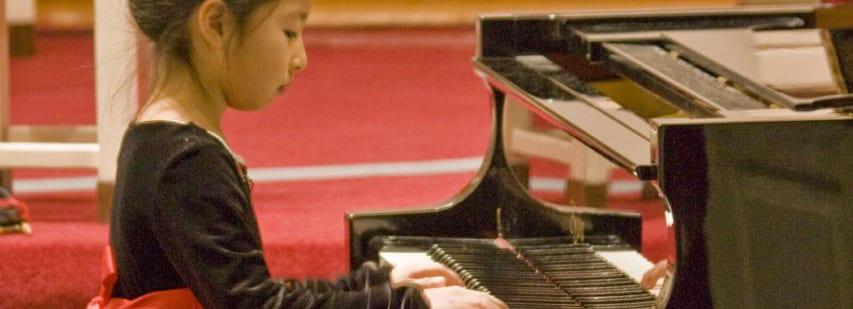Piano lessons for kids are an investment — so how do you know your investment is worthwhile? Here are some tips for checking in and making sure your child is learning piano at the right pace, courtesy of Brooklyn, NY teacher Liz T…
If your child has recently started taking private lessons, there are certain benchmarks you can follow to assess musical progress as he or she is learning piano. Many parents are unaware of how to track and measure their child’s musical abilities. These guidelines will help you understand what level of theory comprehension and performance standards your child and his or her teacher should be striving for in the first year of piano lessons.
First Month
Students should begin learning piano by focusing on the right and the left hands, with their correlating numbers for each finger (1-5). Students should begin reading music with these numbers only. This will help train them how to read music and play the piano comfortably at the same time. Students should practice both the left and right hands, starting with 1-3, their thumbs on middle C, playing the white notes on the keyboard, and then using their 4th and 5th fingers.
Three Months
Now that your child is comfortable with identifying their fingers with numbers, they should be moving on to learning the actual note names on the staff paper. They should be familiar with the lines (Every Good Boy Deserves Fudge) and spaces (FACE) in treble clef and the lines (Good Boys Deserve Fudge Always) and spaces (All Cows Eat Grass) in bass clef, to quickly identify the notes. Students will also start to interpret simple rhythms, such as half notes, whole notes, quarter notes, and so on.
Six Months
At this time students will be introduced to scales, starting with the easier scales (C, G, F). Learning these scales will also help your child become familiar with the accidentals (sharps and flats). The combination of analyzing the correct note names and rhythms will help students learn simple songs to play.
One Year
At this time, students should be comfortable with reading the notes on the page and practicing their scales. This is also a good time to introduce chords, playing multiple notes in the chord triad in the right and left hand. It may take a while for your child to learn chords, depending the size of their hands. Some students love hammering down on the piano playing chords, while others can be intimidated!
All students have different learning styles and paces. Depending on the age of your child, these timelines could vary. Some students may hit these target goals months before the average student is expected to comprehend these subjects, while others may need a few more weeks or months to develop their skills. I wish your student all the success, and if you want to make sure your student is on the right track in their piano lessons, find a great teacher today at TakeLessons!
 Liz T. teaches singing, acting, and music lessons in Brooklyn, NY, as well as online. She is a graduate of the Berklee College of Music with a B.M in Vocal performance and currently performs/teaches all styles of music including Musical Theater, Classical, Jazz, Rock, Pop, R&B, and Country. Learn more about Liz here!
Liz T. teaches singing, acting, and music lessons in Brooklyn, NY, as well as online. She is a graduate of the Berklee College of Music with a B.M in Vocal performance and currently performs/teaches all styles of music including Musical Theater, Classical, Jazz, Rock, Pop, R&B, and Country. Learn more about Liz here!
Photo by PBoGS
Suzy S.

